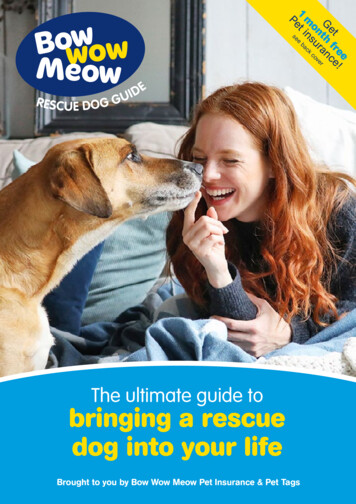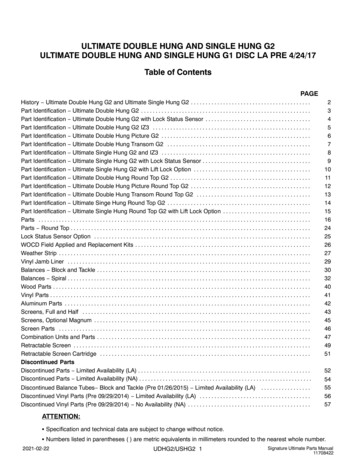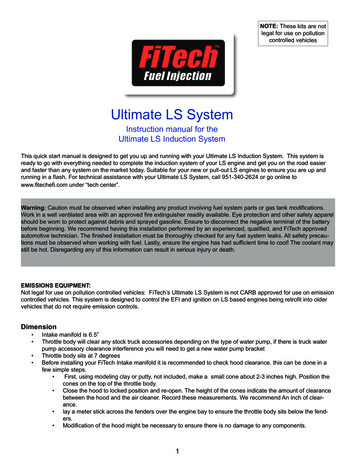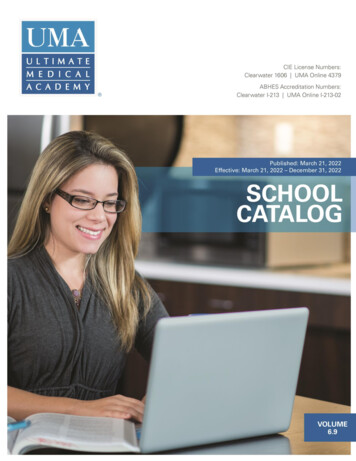
Transcription
ee !et fr ceG th ran eron u covm ns ack1 t i ee bPe sRESCUE DOG GUIDEThe ultimate guide tobringing a rescuedog into your lifeBrought to you by Bow Wow Meow Pet Insurance & Pet Tags
RESCUE DOG G UIDEwelcome & congratulations onyour new familymember!We would like to commend you for choosing to adopt your dogfrom a shelter or rescue organisation. Now that you have givena dog a second chance in life, you want to make the transitionto life in your home as easy and stress free as possible for bothof you.We have developed this booklet to provide guidance, and tohelp ensure a great start for you and your new dog. Some rescuedogs will adapt faster to their new home environment and newowners, whereas others will take longer, however all requirepatience above all else.From the moment you pick up your dog, you will becomeeverything to them, and they will be immensely grateful for theirnew chance in life. The first few days together are exciting forboth you and your dog. Take your time getting to know eachother and make it special, so that you develop a bond with eachother.In this guide, we answer some of the most common questionsthat new rescue dog parents have, and give advice on importanttopics. These include where your dog should sleep, when it is safeto let them off lead, teaching new behaviour to older dogs, aswell as how to establish rules and routine.Your rescue dog will try to find its place in your home and willcrave your attention and affection above all else. At first, hemay be unsure of your permanence, and will follow you around,worrying that you might leave him behind.What he needs now is stability and safety, and a routine to helphim settle. For a stress-free life together, put your efforts intoteaching your dog what you want him to do, rather than tellinghim what not to do. Take it easy and be patient, give lots of love(and treats), and invest time training and introducing him to hisnew life with you.This guide has been written by dog trainers in cooperation withrescue organisations. It has lots of helpful hints, checklists andinteractive elements for you to complete. We hope that youfind it of value. If you have adopted a puppy, you may alsofind it helpful to download our puppy guide atbowwowinsurance.com.au/mypuppy Pet Tag Holdings Limited 2018Download this guide at bowwowinsurance.com.au/rescuedogBoy or girl?We will refer to your rescue dog inthis guide as “he” to avoid having touse him/her and he/she throughoutthe booklet. Of course, all the sameinformation applies to female rescuedogs too!2l
RESCUE DOG G UIDEcontentsl3
RESCUE DOG G UIDEbringing yourrescue dog homeGiving your new familymember the best startBringing your rescue dog home is anexciting time, not only for you and yourfamily, but also for your new dog. Youare giving him a second chance in lifeand he will shower you with love andaffection to show gratitude for thisopportunity.One of the biggest challenges oftaking on a rescue dog is its unknownpast. You are unlikely to have muchknowledge about your dog’s history,including his experience with kids,other dogs, adults and the generalenvironment that he has lived in andbeen exposed to. These experiences(or lack thereof), can have a significanteffect on his behaviour.We want to give you courage andconfidence in raising your new rescuedog. Start the journey by focussing onensuring a smooth transition intoyour home.Whilst some dogs adapt quickly, somemight need more time and may getstressed with too much change atonce. Take it easy and try to makeall experiences positive for your newfamily member.4lNo dog has bad intentions and manybehavourial problems can be modifiedand solved with time and dedication.Just because your rescue dog may lacktraining and socialisation, doesn’t meanhe is ‘broken’ or badly behaved. Dogsare willing to learn and please, and itis in their nature to want to adjust totheir new home environment.As your dog will look for guidance andleadership, teach him what is and isn’tallowed in your home. Try to spend asmuch time with him as possible overthe first couple of days to create abond and show him how to figure outhis brand new world with you.Be positive and encouraging and takethings slowly. Make sure you don’tinvite too many people over to yourhouse at once - give your dog thechance to settle in and get used to hisnew family members first before youintroduce others.The big first dayWe suggest that you plan to pick upyour dog from the shelter earlyin the morning. That way, youhave the day to spend withhim and can start introducinghim to his new life. Ideally,you can take some time offwork to spend at home with him tohelp settle him in. Everything will benew to your dog and he might getoverwhelmed. Ensure you take thingsslowly and give him time to adjust.Before leaving the shelter/pound/rescue environment, we suggest youtake him for a short walk so he can doa wee and sniff around. Bring a chewtreat with you and settle him into yourcar before driving off. You may preferto bring someone else along with youto drive so you can comfort your newpooch in the car.We recommend transporting him in acrate, or securing him with a harness sohe can’t move around in the car whileit is moving.
RESCUE DOG G UIDEOnce you arrive home, and beforeentering your house, take him foranother walk around the block toshow him the neighborhood. Makesure you choose a quiet route - you don’twant to overload him by walking himpast potential environmental challengessuch as a busy bus terminal or loudconstruction sites. Make sure to praiseand reward him for good behaviourbefore entering your house, and givehim the opportunity to toilet outside.We suggest that you doggy-proof yourhouse prior to bringing him home(read more about this on page 9).Ensure that you also close off all roomsthat are off limits to your dog. Whenbringing him inside his new home forthe first time, let him investigate andsniff around the house and gardenwhilst on the leash. Point out thingshe needs to know like:where his water bowl and foodbowls are, and give him a smallfeed;where his new bed is and placeswhere he can relax;where his toys are;where he should go to thetoilet, as even adult dogs canget confused and toilet inside ifdisoriented. (Read more on toilettraining on page 31).On the first day, ensure that he onlymeets close family members that live inthe house with you. Other family andfriends can be introduced at a laterstage. If you have other pets at home,make sure you introduce them safely.(Read more on page 8).Your dog’s first nightAt the start, your dog may be nervous,confused and worried that you willabandon him. He won’t know his placein his new home yet. To help him feelmore secure, show your dog his bedand reward him for going in it andstaying there. You can also try puttingyour dog’s bed next to your bed forthe first couple of nights to help himsettle in.Many rescue dogs becomeunsettled at night in the first fewdays. It might take your dog afew days to understand that hewill now be living permanentlywith you and begin to relax.Once your dog starts sleeping throughthe night on his bed, move the bedslowly in stages out of your roominto the room where you want himto sleep at night, and at other timeswhen you aren’t at home.Some dogs may worry they will beabandoned again, so they may checkat night to see if you are still there.Assure them they are ok and sendthem back to their dog bed.l5
RESCUE DOG G UIDEFirst weekSupervise your dog and give himlots of opportunities to toiletoutside, ensuring you reward himwhen he goes where you want himto. Give your dog a routine in themorning and evening, as it willhelp him to settle in better andunderstand what to expect.A morning and evening walk willbe good bonding for you andyour dog.Start training some basiccommands and expose himslowly to the world so you cansee what he is comfortable withand where he might need somemore socialisation and training.Be patient and forgiving if thingsdon’t go the way you may haveexpected. Your rescue dog may notbe socialised to certain things andmay be scared of them. He may nothave been taught something, orthe commands he knows may bedifferent to the ones you use.6lDo not let your dog off the lead for thefirst few weeks until you have bondedand established a good recall command.At the start, take your dog to a fenceddog park or keep him on a long leashto ensure he doesn’t run away whenhe gets scared or disoriented. Don’tforget, you are just getting to knoweach other.Slowly start introducing yourdog to your extended family andneighbours. Use yummy treats tomake all these new experiencespositive. Begin leaving your dogfor short periods of time. Thiswill help him to learn to settlehimself in your house and get himprepared for later when you mighthave to go back to work. See theHome Alone Plan on page 32.First monthsPeople often find that the firstmonth or so is like a honeymoonperiod where you begin to getto know each other. Just like ina human relationship, duringthis time, your dog will want toshow off the best side of himself,and certain behaviours may besuppressed or somewhat inhibited.Once your dog adjusts and makeshimself feel more at home, certainbehaviours may come through thatweren’t there at the start.Make sure you provide as muchstructure as possible during thistime and follow the schedule thatyou have established, so thatyour dog knows what you expectfrom him and what he can expectfrom you. Clear boundaries andguidelines give security to yourdog and will help him learn therules and settle in faster. Investtime in training and bonding withyour dog. After a few months,he will know who and where hebelongs and should have settled inand bonded well.Watch your dog closely over thefirst couple of weeks and monthsto understand his emotional statearound new things he encounters.He might be fearful or scared ofthings that you never expectedhim to be unsure about. If youcome across behavioural issues,it is always beneficial to start atraining course or seek help froma certified professional dog traineror behaviourist.
RESCUE DOG G UIDEChanging your dog’s name andcreating name recognitionAs you are giving your dog a newlife, we also recommend choosinga new name for him that is toyour liking. This will help providea fresh start for your dog andleave old memories behind.It should only take a few days foryour dog to start recognising hisnew name. Here is how to start theprocess:1 Go to an environment wherethere are no distractions ornoises, such as the living room,hallway or kitchen.2 Say your dog’s new name, waituntil he hears it and looks up.Then say “good” and rewardhim with a treat.3 Next, let your dog investigatehis environment. You can evendistract him from looking at youby gently kicking a toy away.Then say his name, and thesecond he looks up, say “good”and follow immediately with atreat reward. Repeat the samething approximately 10 moretimes.4 If your dog isn’t interested inthe treats you offer, find a moreappealing treat or use a toy as areward for looking at you whenyou say his name.5 Multiple repetitions are requiredover a couple of days until yourdog understands that hearinghis name means ‘look and cometo my human for a treat’.6 We recommend you do thisexercise over three sessionsper day, for 10 repetitionsper session, over the courseof 3-4 days. Start movingtowards locations with higherdistractions, like the backyard,outside the house, or the park.Keep your dog on leash ifoutside your home environment.F in d t h eeperfect namroughSearch thamess of pet nthousandw.com.auat bowwoOurStory"Adopting our little GermanSpitz, Benji, from a shelterwas one of the best thingswe ever did. Aged twoat the time, Benji movedquickly not just in our homebut also in our hearts.Be it camping, traveling,visiting friends, hikes in thebush or just hanging out atthe beach - he is the bestbuddy we could want for allour adventures."Kerstin, Ian & Benji,Chifley NSWl7
RESCUE DOG G UIDEOurStoryIntroduction to otherdogs and animals inthe householdDogs are very adaptable and, when managed correctly, can get usedto other animals. Slow and steady introductions are recommended tohelp ensure they get along.If you already have another dog, ideally you would have brought himto the pound or rescue organisation for a meet and greet, beforemaking the decision to adopt your new rescue dog.When bringing your rescue dog home, it is recommended that youpick a neutral location (like a park or a friend’s garden) for the firstintroduction, to help reduce territorial behaviour. Take it easy and tryto make it fun for both your new and old dogs. Follow these simplesteps:1 Keep both dogs on lead;2 At first, allow them to justwalk along next to each otherfor 10 minutes or so withoutinteracting;3 Once they have settled nextto each other on a walk, thenintroduce them and let themplay with each other;4 Go home and let the newdog investigate his new placewhile the other dog is on awalk or confined in a crate;5 Once your new familymember has investigatedhis new home, give bothdogs some supervised timetogether for short periods;6 Watch for any warning signsin both dogs, to ensure theyare comfortable togetherbefore allowing longerperiods of playtime;7 Avoid giving treats or foodtogether, as even the mosttolerant dogs can fight overfood. It is not worth the riskand it is recommended toalways feed them separately.If you have any other animals such as birds, bunnies or cats in yourhouse, please keep your newly adopted dog on leash or in a cratewhen first introducing him to these other animals. You might notknow if your new dog has had exposure to other animals before,and if he was tolerant of them.In the first few weeks, ensure that you never leave your new dog andany other animals unsupervised until you are sure they are gettingalong and are calm and relaxed together. If you see any signs of stress,overexcitement or fearfulness, we recommend consulting a certifieddog trainer and behaviourist to help. For more information please goto: pets.webmd.com/dogs/introducing-new-dog--cat8l"We recently adopted our 6-yearold Husky, Dakota, from Homefor Huskies in Victoria. Dakotadidn’t have the greatest startto life, being tied up to a housefor most of it, and has beenchallenging to say the least.He is afraid of males and pullslike a freight train, althoughwith patience, training anddetermination, he’s improvingevery day. He makes a great sleddog and I have begun racing himthis year. He’s already showinggreat potential and is really fast.It is such an awesome feelingadopting rescues. It’s difficultto explain, though there’ssomething you see in their eyesand feel in their hearts thatmakes them so special.Michelle & Dakota,Lyndhurst VIC"
RESCUE DOG G UIDEDoggy-proofing your homeMake sure you doggy-proof your house before your new dog’s arrival,so you can focus on spending quality time with him when he firstarrives home.Some rescue dogs might not be toilet trained yet or may get confusedat the start. It is recommended to block off access to various roomsand slowly introduce your dog to more rooms in the house. Use babygates to help with this process.Ensure that all power cords are hidden, kids’ toys, cleaning products,medication and other potentially dangerous or breakable items areput away, and that shoes and any valuable items are out of reach.Check for gaps under fences, gates and garage doors to ensure yourdog cannot escape. Self-latching gates can be handy as they ensurethe dog can’t follow you out of an open gate.Top tips for doggy-proofing your home4 Check for gaps in fences/gates/doors4 Remove all valuable items4 Install self-latching gates4 Install baby gatesTop 10 most poisonous plants for dogs(includingdaffodils, onionsand snowdrops)RhMnroModendod(includingazaleas)ato plamsntbany ulaneph oteanderOl(Madagascarjasmine)yellowoleanderis& DaffopshroomussLiliumsbsIrisdilsunfelsiaBrToCheck your backyard to ensure you don’thave any poisonous plants for dogs. Wealso recommend teaching your dog agood “leave it” command and showinghim what he can chew instead of plants.Stmay never have learnt what to chewand what not to chew. Some dogs maynot have had exposure to an outsidegarden, and will investigate thoroughlyby chewing everything in sight.TuliAs you are unlikely to be aware of yourrescue dog’s past, it is important totreat him like a puppy and not allowscavenging or chewing on plants. Evenolder rescue dogs can behave likepuppies and chew everything, as theyIMPORTANT: Train your dog not to chew any plants or take foodoff the ground. If your dog shows any signs of being unwell and you suspecthe might have chewed or eaten something, take a sample of the plant/foodto your vet and get him checked straight away.l9
RESCUE DOG G UIDEdoggy arrivalequipment checklistHaving the right food, supplies and equipment ready before your dog’sarrival will help you to maximize your enjoyment of your new family memberwhen you bring him home. We have put together a checklist of supplies youwill need. We suggest that you use it as a shopping guide.Basic Supplies4Food dish4Water dish4Dog bedEnsure you get one that fits your dog your dog should be able to comfortablystretch out on it. It is recommended tochoose a bed with washable covers.4CollarChoose a collar that allows you toadjust the size and has a good clip onit. The collar shouldn’t be too heavyfor your dog’s neck and should sitsnuggly so you can fit two fingersunderneath it when around his neck.410 lID tagChoose a quality tag from Bow WowMeow, your local vet or order online atpet-tags.com.au. Get your dog’s nameand two phone numbers engraved onthe tag (in case you can’t be contactedon one of them).44LeadA good quality lead is a greatinvestment and should last up to fiveyears. The lead should have a goodquality clip and shouldn’t be too heavyfor your dog. A retractable lead isnot recommended for walking in thestreets, as you won’t be able to haveeffective control of your dog when it ismetres ahead of you. Remember, youare just getting to know your dog anddon’t know how he might react to hisnew environment.Car harness or seatbelt buckleIn some states you are required by lawto keep your dog restrained whilsttraveling in the car. Your options area harness, crate, seat buckle clip or ametal mesh barrier between the backarea and passenger seats. Even if thelaw in your state does not enforce it, itis important to keep you, your familyas well as the dog, safe and it is highlyrecommended to restrain your dog inthe car in case of an accident.
RESCUE DOG G UIDEFood4Food for mealsAsk the shelter or rescue organisation what dry food they havebeen feeding your dog. If possible, we suggest you purchase a smallbag of the same brand first and keep your dog on the same foodfor about one or two weeks before you transition him to anotherbrand of your choosing. This is to avoid introducing too muchchange at the start. Read more about your dog’s diet on page 26.Your rescue dog might be nervous when first arriving at his newhome and this could cause soft stools. If you immediately changediets you won’t know if his soft stools are caused by food ornervousness. Transitioning gradually from one brand to the nextwill help avoid further stomach upset.Your vet may recommend a specific brand of dog food if your newrescue dog is underweight, or for other reasons that requirea special diet.4Training treatsWe recommend using natural dry treats, or your dog’s dry food as areward, as they can easily be carried in your pocket. Having treats ordry food on you helps you to reinforce good behaviour on the spotfor your rescue dog. For training in the park or elsewhere outsideyour home, it is recommended to use higher value treats such asbarbeque chicken meat.4Chew treatsChew treats are an especially useful distraction for the first fewtimes you leave your dog home alone. They will keep him occupiedrather than stressing about you leaving, and help avoid himchewing things he should not. Common chew treats are pigs ears,antlers, sheep ears, hooves or bully sticks. Please ask your local petshop for good quality chew treats that are made in Australia orNew Zealand.4Training PouchYou may have seen training pouches being used by dog or animaltrainers. We recommend you invest in one if you are committedto having a well-trained dog. This is because dogs learn throughrepetition, and behaviours need to be reinforced in under threeseconds for your dog to remember what he received the rewardfor. By always having a treat on hand, and rewarding positivebehaviour, you will quickly instil good manners. The more regularlythe right behaviour gets reinforced, the faster your rescue dog willthrive in his new home.Toys4ToysIt is worthwhile testing if your dog likes toys and balls beforebuying lots of them. Some dogs are not interested in toys at all.Once you know that your dog likes to play with toys, a toy basket isrecommended for storing and rotating toys to keep them exciting foryour dog. We recommend having around 10-12 different toys foryour dog.Good quality toys that can’t easily be destroyed are recommended.It is better to have two quality toys that you can leave your dogwith, than ten that require constant supervision. Food toys, suchas Bob-A-Lot, Kong, or a Snuffle Mat, provide mental stimulation,and can help an active dog to be calm. These toys can be filled withfood and entice the dog to become engaged trying to get the food.Fluffy toys can be fun, however their use should be supervised.Fluffy toys can easily get destroyed, creating not only mess, but alsopotentially forming bad habits that could lead to him destroyingbedding, cushions and other fluff-containing household items.l 11
RESCUE DOG G UIDEGrooming4Dog shampoo and conditioner4BrushChoose a soft brush for short haired dogs or a wire one for longhaired dogs. Even if you are planning to get your dog groomedregularly, you will still need to brush your dog in betweengrooming to avoid his fur getting matted. Many people are underthe impression they do not have to brush a short haired dog,however, to minimise shedding, regular brushing is recommended.4Nail clippersPlease take extra care when clipping your dog’s nails - manypeople clip too short and the nail bed can start bleeding. Go toyour local vet or groomer to get your dog’s nails clipped or takeextra care when doing it yourself. Ensure you have lots of treatsready for your dog’s first nail clip with you or the groomer, asmany dogs do not like getting their nails clipped.Miscellaneous4Baby gates or a puppy play pen are great if your dog is still apuppy, or if you want to limit access to certain areas of your house.4CrateUseful if you wish to crate train your dog/puppy.4ADAPTIL collar or dispenserThis is a pheromone collar that can make your rescue dog feel safe,and help settle him into his new home. Read more at adaptil.com.au4Flea and tick treatmentPlease follow your vet’s recommendation for thecorrect treatment and dosage.4Worming tabletsPlease follow your vet’s recommendation and ask the rescue or poundwhen the last treatment was, to ensure your dog is up to date.4Pet insuranceIt is important to take out pet insurance from the very start, to ensureyour rescue dog is always covered. Bow Wow Meow is Australia’s No.1 Rated Pet Insurer and winner of Product Review’s 2019 Pet Insurerof the Year.Get one month FREE pet insurance for your rescue dog –just use promo code RDG38 when getting a quote atbowwowinsurance.com.auOurStory12 l"When our dog Oscar becameincreasingly anxious, we decidedto look for an older dog as a friendfor him. We found a 12-year-oldboy named Matthew who had beensurrendered to Labrador Rescue.Matthew (who I call Matty Matt) wasfairly stressed when he arrived. I toldOscar he was getting a new brotherand showed him pics. We waited inthe park as he was driven over tomeet us, and as the car stopped,Oscar ran over to say hello. The restis history Matthew is now 13 1/2 andstill going strong, and we are so gladthat we brought him into our family.Nicola & Matthew,Heidelberg Heights VIC"
RESCUE DOG G UIDEIntegratingwith the familyOnce you have made the decision to adopt a rescue dog, it isimportant to sit down with the family and discuss rules andresponsibilities around your new family member. These includelisting the household rules your new dog needs to follow, thecommands you wish him to learn, and agreeing who will beresponsible for feeding, taking him for walks and grooming.It is preferable to do this before you bring your dog home so thatconsistent rules and routine can be established from the outset.This will help your new fur baby acclimatise to his new home andmake it very clear amongst family members who is responsiblefor what.Instead of just using the word “No”, we recommendyou teach your dog the “Leave it” command to stopundesirable behaviour such as chewing shoes, eatingplants in the backyard, digging etc. Your dog maynot know the word ‘No’, or may have a negativeassociation with the word from its previous life,causing it to become scared when you use it .Establishing family rulesSetting up clearly defined rules and boundaries that arereinforced by everyone in the household will help your dogto learn faster, settle in quicker and be less confused.To help you get started, here are some topics you may like tothink about before your adopted dog arrives home.Is your dog allowedon the couch?YESNO(If you answered YES, teach your dog a commandto get up on the couch. That way you can stop himgetting on it when he is muddy or wet).Is your dog allowed to sleep onyour or the kids’ beds?YESNOIs your dog allowed to swim inthe family pool?YESNO(If yes, teach your dog how to get in and out of thepool to avoid the risk of drowning)Is your dog allowed to sit underthe table during family dinner?YESNOIs your dog allowed to beg atthe table?YESNOIs your dog allowed to jump upon you or other people?YESNOIs your dog allowed to kissand lick faces?YESNOAre there any areas in the housethat are off limits?YESNOAreas off limits are:Review your rules after a monthYou may have changed your mind on some areasand it could be useful to get everybody together toreview and readjust the rules after a month or so.You may also find that you need some help withfurther training and should consider bringing in adog trainer to help you.l 13
RESCUE DOG G UIDEDeciding who does whatHelp make your new dog a true family dog that bonds with all family members, by sharing the responsibilities of caring for him. We suggestyou record the name of the person responsible for each task in the table below. This will ensure that everybody is involved, and duties won’tbe forgotten.Make sure that a responsible adult takes the dog out for walks in the first couple of weeks to gauge if he is fearful of anything. A child may notbe able to read a dog well enough or be able to get him out of a dangerous situation. It is also not recommended to let children under 12 yearsold walk the dog by themselves, and it is important to consider the size and strength of the dog compared to the alkeveningBrushingTrainingTeaching your dog commandsTeaching your dog commands to follow will make it easier for him to learn his place in the family and to respond to all family members. The morecommands a dog can follow, the more freedom you can grant him (e.g. if your dog has a reliable recall, you can grant him more off-leash freedom).Your dog will most likely already know a few commands. The rescue organisation you got him from may advise you on any commands he knows,and if so, you can build from there.Your dog will learn new commands quickly if everyone in the household uses them and reinforces and rewards the correct behaviour. To makethis step easy, please find a sample list with commands below, which includes space to add your own commands and desired behaviours. If youneed help with training your dog, it is best to seek a dog trainer’s help. Your local shelter or rescue organisation will be able to provide you withsome contacts. Learn more about training on pages 30-31.DesiredbehaviourVerbalcommandFor an initial assessment, rate how wellyour rescue dog knows this command1 doesn’t know well 5 knows wellSitSit12345StayStay until you come back12345ComeCome back to me12345On your bedGo to the dog bed and lie down12345HeelWalk nicely on lead on your left hand side,stop and sit each time you stop.12345Leave itLeave/drop whatever he has picked up or islooking at and don’t touch it again.12345Drop or downLie down12345GiveGive the toy/ball12345FetchRun after the ball/toy and bring it back12345Off & on the couchGet on the couch when I invite you and get offthe couch when asked.12345123451234512345Add your own:14 l
RESCUE DOG G UIDEyour children and your new dog.getting it right from the startCongratulations. By adopting a rescue dog, youare teaching your children the value of saving aprecious life.Bear in mind that your rescue dog might not have had muchcontact with children in its previous life and may need to learnwhat great playmates they can be. Take it slow, ensuring the kidsdon’t overwhelm your dog at first.Kids and dogs often develop a close loving bond, and giving yourchild a dog is a wonderful gift. Owning a dog is an opportunityto teach your children responsibility and respect for animals, notto mention all the fun they are sure to have together!In this section, we recommend lessons to teach your child and fungames for your child and dog to play together. Before you begin,please read this booklet to the end to ensure you understandyour dog’s body language and how to interact safely.OurStory"We rescued our gorgeous Kobitwo years ago.He is beyond affectionate, full ofbeans and our favourite alarmclock in the morning. He lovesoutdoor adventures, car rides,his toys & food, food, food!He is the greatest welcomehome after a day
This guide has been written by dog trainers in cooperation with rescue organisations. It has lots of helpful hints, checklists and interactive elements for you to complete. We hope that you find it of value. If you have adopted a puppy, you may also find it helpful to download our puppy guide at bowwowinsurance.com.au/mypuppy










